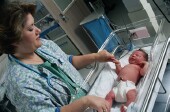Bayesian statistical model useful for describing neonatal intubation competency
MONDAY, April 6, 2015 (HealthDay News) — Neonatal intubation competency can be modeled using a Bayesian statistical model, according to a study published online April 6 in Pediatrics.
Stephen D. DeMeo, D.O., from the Duke University Medical Center in Durham, N.C., and colleagues conducted a retrospective observational study of resident-performed neonatal intubations between 2005 and 2013. Intubation competency was defined as the resident attaining a 75 percent likelihood of intubating their next patient successfully using a Bayesian statistical model. Four hundred seventy-seven unique intubation attempts by 105 residents were analyzed.
The researchers found that the path to proficiency was defined by a categorical or milestone learning event, following which, all residents moved in a similar manner toward competency. Four cumulative successes were needed to achieve competency. During the study period, only 23 percent of the residents achieved competency. Compared with those who were successful on their first two opportunities, residents who failed on their first two opportunities needed nearly double the intubation exposure in order to achieve competency.
“Achieving competency in neonatal intubation appears to be a categorical or milestone learning event whose timing varies between residents,” the authors write. “The current educational environment does not provide adequate procedural exposure to achieve competency for most residents.”
Copyright © 2015 HealthDay. All rights reserved.








